For centuries the principal ingredients in the popular Western image of the Middle East have been spirituality and sex. As early as the sixteenth century, European writers were using the second half of this irresistible combination to describe and define a venerable eastern art form, the belly dance. The ignorance and laziness of innumerable popular writers and artists ever since has only reinforced the stereotype. The belley dance first made its belated but sensational debut in North America at the World Columbian Exhibition in Chicago in 1893, but it was impossible to take seriously given the carnival atmosphere at the fair.
Presently, it is often termed the ”Oriental dance” , a label apparently designed to lend modesty by shifting the point of reference from anatomy to geography. Yet, the sexual stereotype still remains and most of the belly dancers do little to shake it off. The ”oriental dancers” we now come to know, are more in the tradition of American burlesque than of anything else.
As the fame of the belly dance spread to the Western World, it became something of an embarrassment to the cultural and political custodians of the east, who began to consider themselves above their own popular arts. In 1850, a ruler of Egypt banished all belly dancers from Cairo; the present regimes of Egypt and its neighbors, though less extreme in this regard, content themselves with requiring the dancers to cover themselves from neck to ankles. The quality and character of the dance itself is in a state of decline despite its intellectual significance. This is because governments like Egypt encourage instead the performance of a sort of folkloric dance that only vaguely resembles the belly dance. It offers no assistance to the original and authentic belly dance incarnations, likely in the hope that it will be confined to the tourist trade and benighted masses.
The most artistic form of the belly dance, which emerged in the nineteenth century and reached a high point in the 1960’s , called for movement across space as well as muscular virtuosity while standing in one place, and was performed by well trained dancers. This dance, which has already been debased in the West by its assimilation to the strip tease, is in danger of being ”elevated” and modified into folklore by the many solemn and fundamentalist cultural czars in the Middle East.
The origins of the belly dance are vague. The dancers claim that their movements and gestures are deliberately based on the dances of ancient Egypt. But they are hardly experts. Whatever their accomplishments, Egyptology is likely not among them. These claims are usually made for the same reason that they minimize the sexual aspect of the dance. That is, to give themselves what they consider greater respectability , as if their art alone were not enough to recommend them.
The possible affinity between the belly dance and the ancient dances represented in the tombs of the Pharoahs is not a subject many Egyptologists have seen fit to explore. Research has revealed that tomb paintings did reveal gestures and costumes similar to those of the belly dance. In addition, the dance has also been attributed to the Gypsies, who since they traditionally were not given to writing articles and books, have no means of refusing all the dubious honors heaped on them. Whatever its origins, the belly dance in recent memory has been thought of as Middle Eastern, mainly because the dance has long been cultivated there.
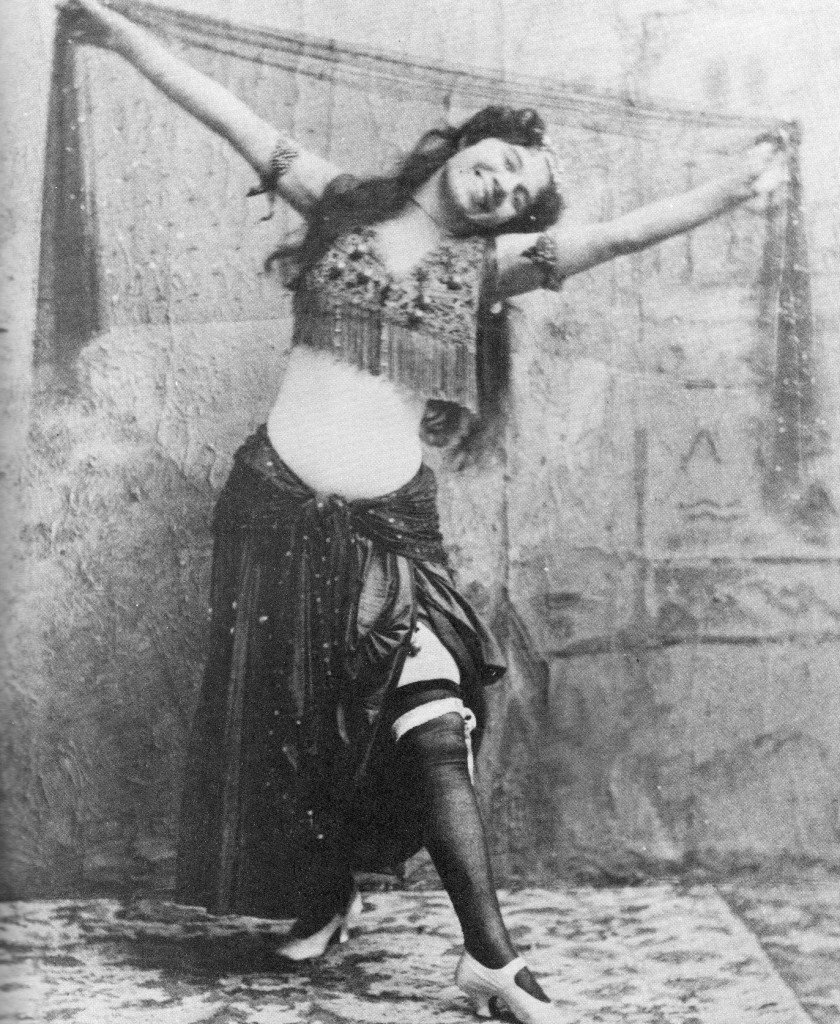
Little Egypt, who popularized the hootchy-kootchy at Coney island around 1900, was less traditional in her approach
There is no doubt that the belly dance flourished in Turkey, and among Gypsies as well. Sulukule, the old Gypsy quarter of Istanbul, was well known for its dancers. But nothing can refute the well attested fact that, however much the official guardians of culture in Cairo may regret it, or attempt to disown it as a Turkish importation performed by slaves, and degraded at street level after it left the palaces
e belly dance is justly identified with Egypt and has been since the nineteenth century.The belly dance comes in three varieties, depending on your taste for flavor. The folk dance of the masses where the sexual element is definite, but subdued is the most common. Then, the traditional dance of the professional entertainers and the teachers of amatory arts to the ladies of the harem; as one would expect, not much locomotion, but considerable muscular movement, especially of the pelvis and environs. Finally, and not least, the cabaret style, based on variation no.2, but some locomotion and considerable grace have been added to it by dancers with serious training.
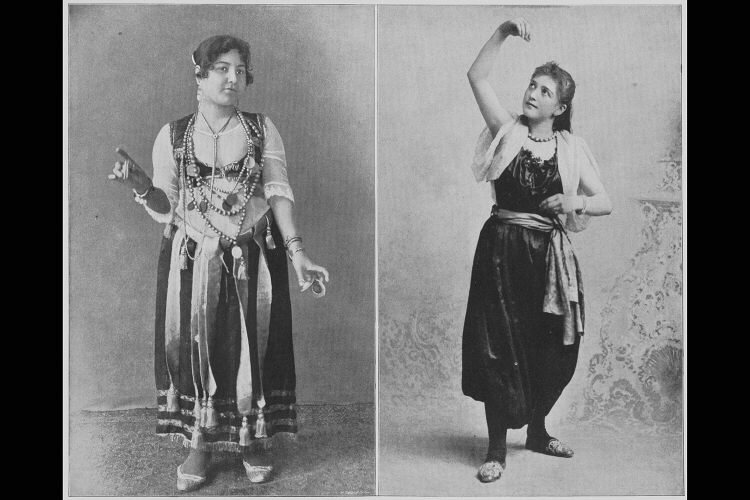
''These dancers, on the right, are Egyptian and traveled to America for the Chicago Worlds Fair. As you can see, they are in no way exotic according to our modern interpretation of the word, but to the tightly corseted Victorian ladies, these women were the most scandalous creatures ever seen in America. Yet for some unknown reason these prim and proper Victorian folks returned to the exhibit time and time again. ''
It was only a matter of time until some enterprising man would bring the belly dance to the West. It arrived at the Paris International Exhibition of 1889 in the form of an ”Algerian Village” A young American promoter of popular entertainment, Sol Bloom, saw it: ”I doubt very much, whether anything resembling it was ever seen in Algeria, but I was not at the time concerned with trifles,” With all the judgement of his twenty years, Bloom paid a thousand dollars for the exclusive right to present ”dancers,acrobats,glass eaters and scorpion swallowers” in America. Bloom brought the Algerian Village to the World’s Columbian Exhibition in Chicago in 1893,….” When the public learned that the literal translation was ‘belly dance’ they delightedly concluded that it must be salacious and immoral. The crowds poured in. I had a gold mine.” Money, however did not exclude art for Bloom. ”As a matter of strict fact”, he wrote, ”the danse du ventre, while sensuous and exciting, was a masterpiece of rhythm and beauty. It was choreographic perfection”. Henry Adams wrote that he found the Midway a ”sweet repose” adding, ”I reveled in all its fakes and frauds, all its wickedness that seemed not to be understood by our innocent natives, and all its genuineness which was understood still less.”
Although the dancers now move about more than they did in the nineteenth century, the belly dance is still essentially an art of form rather than locomotion. ”The flute makes the sound of the serpent, so I must make his movements” ( dancer ) Both are in a sense all torso and no legs. Since the belly dancer achieves her main effects by moving various parts of her body while standing still or in a graceful, but slow walk, the total impression is one of a succession of still pictures. Like Arab art in general, it depends upon form, the arrangement of parts within a compressed area, as in a mosaic and geometric pattern.
The belly dance is sexual, to be sure, but it is so in the tension it creates between display and modesty, exposure and concealment. The dancer alternates provocative movements with sedate poses and gestures. Flaubert wrote his mother when he arrived in Alexandria: ” …if you don’t see their faces, you see their entire bosoms. As you change countries, you find that modesty changes its location, like a bored traveler who keeps shifting from one seat in the carriage to another.” By combining modesty with display and by its flowing, undulating movements, the belly dance has a pacifying quality that attenuates its sexual excitement, often with a semi-hypnotic effect. Flaubert’s affair with a famous dancer in Egypt left an indelible mark on his spirit and perhaps on his body. A later medical analysis suggested he might have died of the effects of syphilis contracted in her company.
”People have always endowed their gods with human frailties, and thus these deities had to be appeased with the best of their possessions: the fruits of the field, the fatted calf, and even human beings. The fertility cult in particular existed in all ancient civilizations. The great Mother Goddess appears under different names such as Mylitta, Isis, Ashtoreth, Astarte, Ishtar, Aphrodite, Venus, Bhagvati, Parvati and Ceres. The function of these goddesses was reproductive, not just in the limited sense of human beings, but in the greater sense of the planet itself. They ensured the cycle of the seasons which regulated the growth of crops. They were responsible for the increase of livestock and the perpetuation of the race. The well being of the city and the countryside depended upon the goodwill of the regional mother goddess. None of these goddesses were celibate because it ran counter to their function. Neither were her priestesses necessarily expected to be celibate. Since the reproductive functions of the goddess were symbolized in the human female’s reproductive organs, it must have seemed very natural to give the goddess the gift of a girl’s service and virginity.”
It is often thought that the Dance Of The Seven Veils is a traditional dance from the Middle East, based on a story about Ishtar leaving a veil behind at each of seven gates as she descended to the underworld. This may be inaccurate. Playwright Oscar Wilde may be the culprit for the Seven Veils myth. In 1896 he wrote a popular play about Salome and her lovers. Richard Strauss then took the idea and composed an operatic creation that had Salome stripping her veils for King Herod. Hollywood and Broadway made Salome and the dance of the seven veils a household term as early as 1903 when Maud Allen, played the part of Salome. In New York, a modern dancer named Isadora Duncan was experimenting with flowing scarves and large pieces of fabric around the same time. All these instances together helped to create the “Seven Veils” mystique.
The belly dance has gone through many changes over the centuries and has often enough in the past been the object of official condemnation and restriction, especially in the Middle East. It has been vulgarized and chastened in return. Its name has been euphemized. But since its continuing popularity in its various forms has never depended on government funding, especially in Egypt, it has survived because it arises from something in the spirit that goes deeper than political and cultural policy.


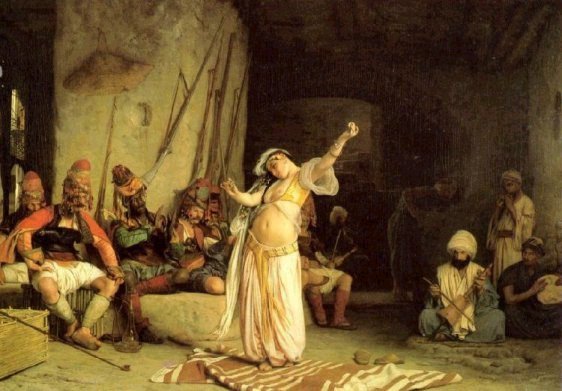
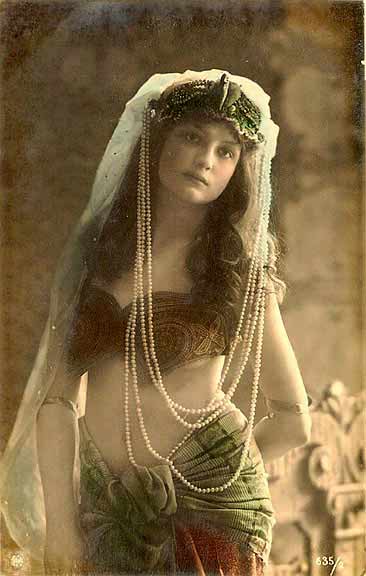
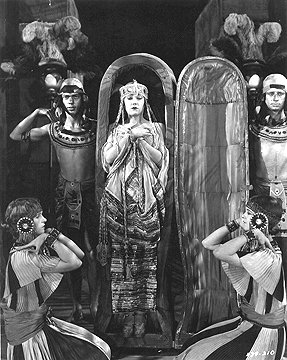
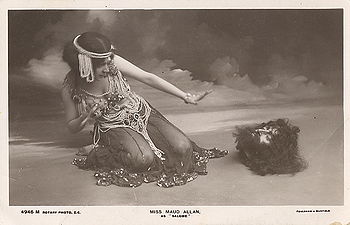
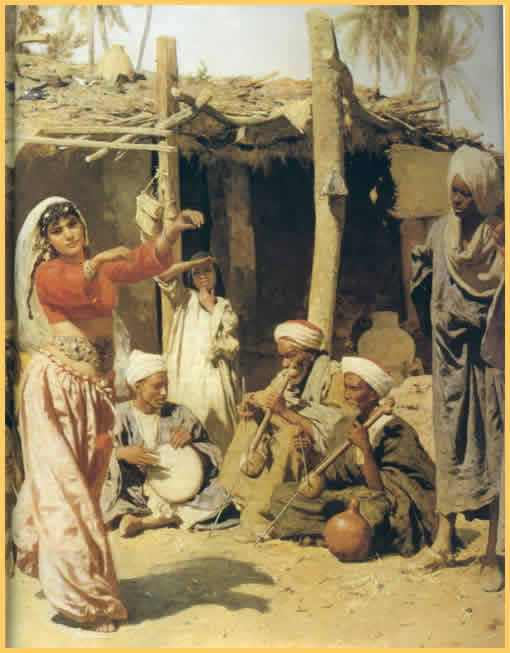



 COMMENTS
COMMENTS